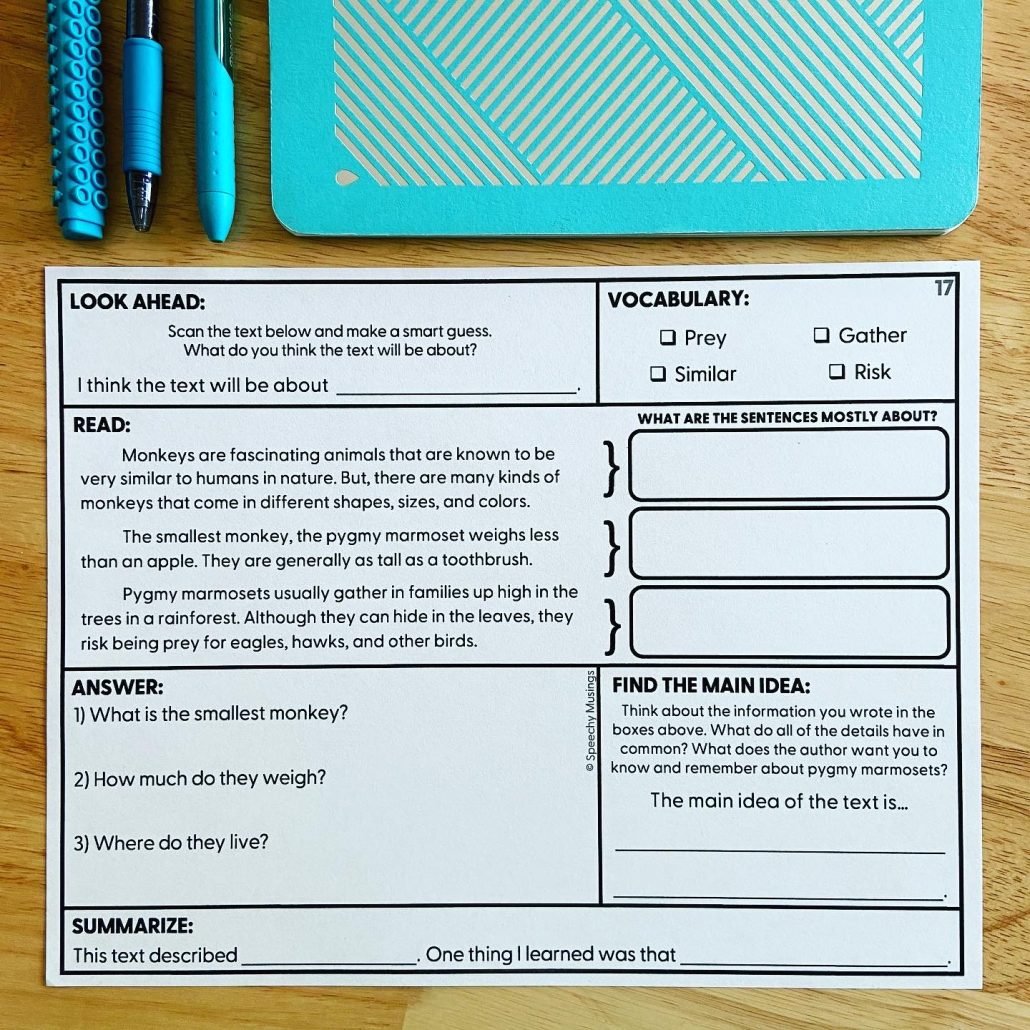Goals for Using Comprehension Monitoring Strategies
- When provided a short text, NAME will find the answer to simple WH questions within the text with 85% accuracy given a familiar visual.
- NAME will comprehension questions about short texts with 80% accuracy across 3 sessions.
- NAME will identify and define at least 3 unfamiliar vocabulary words in a text of at least 2 paragraphs in 2 out of 3 opportunities given a familiar visual.
- NAME independently use one comprehension monitoring strategy (identifying unknown words, breaking apart the text, using a graphic organizer, etc…) while reading a 1-3 paragraph length text in 2 out of 3 observed opportunities across 3 sessions.
- When given a short text, NAME will independently follow a 4 step plan to apply pre-taught comprehension strategies in 3 out of 4 opportunities across 2 sessions.
- NAME will demonstrate the ability to utilize reading comprehension strategies (i.e., visualization, context clues, number paragraphs, highlight, underline, etc.) in order to answer factual and more complex reading comprehension questions with no more than 2 verbal prompts with 80% accuracy.
- Given a short text, NAME will rate their knowledge on the topic and one or more comprehension strategies they could use to increase their understanding in 2 out of 3 opportunities.
Read more about my goals here.
Comprehension Resources
Here are my favorite resources that target comprehension skills:
Teaching Comprehension Strategies
A recent study by Kärbla et. al. concluded, “Thus, the explicit teaching of comprehension strategies supports students in becoming aware of using multiple comprehension strategies, despite individual differences.” (Kärbla et al, 2023)
Strategies are problem-solving steps that help guide your attention to key information in order to complete complex tasks (like comprehending a short text!). Broadly speaking, strategies are a part of how you regulate your attention, understanding, and learning.
As a reminder, strategy instruction should follow, not proceed, direct work on foundational language comprehension skills including Direct Vocabulary Teaching and Complex Sentence Deconstruction. In addition, direct instruction in knowledge of Text Structure should be done before trying to have your students use general comprehension strategies. Check out Comprehension for more information on this.
When teaching strategies to students, I’d recommend following these steps:
1 – Activate background knowledge. 2 – Directly teach the strategy. 3 – Model use of the strategy. 4 – Have learners practice use of the strategy with support. 5 – Give feedback and provide scaffolded, faded supports. 6 – Have learners use the strategy independently.
Once students are ready for it, the top strategies I teach for overall text comprehension are:
🔹 Look Ahead: Scan the text or story with your eyes. What do you see? Make a prediction. Think about what the text or story might be about.
🔹 Learn The Words: Discuss vocabulary words your students will encounter in the text. Have your students underline the words in the text. Provide a child-friendly definition and practice using the word in a sentence.
🔹 Break It Up: Break the text up into smaller pieces. Only read 1-2 sentence at a time.
🔹 Main Idea: What do all of the details, or parts, of the text have in common? What is the one main point or topic?
🔹 Visualize It: Make a picture or movie in your head of what is being described. What is the text about? What is happening?
🔹 Summarize: Tell the most important parts of the text in your own words. What does the text what you to remember?
We can practice these strategies in structured activities like this one:

See all of the strategies at work in that one single worksheet? 🤩
Monitoring Comprehension in Context
It’s important to work on generalization of the targeted strategies in context, using other articles (like those on ReadWorks), as well as your students’ classroom work. This provides an opportunity for your students to monitor their own understanding of text and apply the pretaught strategies.
When working on generalization, I have my students follow the exact same process I listed above (often with a visual). We ‘look ahead’, then we break the text up (by circling paragraphs or literally cutting the piece of paper apart), read it, answer questions about it, find the main idea, and summarize it.
💡 Remember: the overall goal of this work is to boost our learners’ ability to monitor their own comprehension, to notice when something doesn’t make sense, and to apply a strategy to get back on track.
In addition, many students might benefit from visualizing the information to increase comprehension. Others might benefit from a lesson or two about self-talk/think alouds, or listening to the little voice in their brain that talks while they read.
The goal here is to increase your students’ meta-awareness of their own comprehension. I want them to be asking themselves questions as they read like “What is this about?”, “What does this mean?”, “What is the main idea of this?” or “Does this make sense?”.
In order to effectively use comprehension strategies, our students need to be aware of what they already know, where their gaps in knowledge are, and tools they can use to better understand what they’re reading.
Want any easy button to target inferencing and predicting using themed and story units made just for speech therapy sessions? Check out my contextualized units linked below:
Shop Story Units Shop Themed Units









